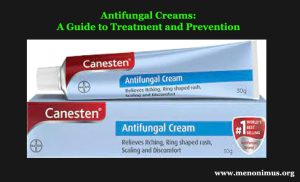Antifungal Creams: A Guide to Treatment and Prevention
Antifungal Creams: A Guide to Treatment and Prevention
Introduction
Antifungal creams are a vital component of modern medicine’s arsenal against fungal infections. Fungi are ubiquitous microorganisms that can cause a wide range of infections in humans, affecting various body parts, including the skin, nails, and mucous membranes. Antifungal creams play a crucial role in managing these infections, providing relief from discomfort and preventing the spread of fungal pathogens. In this essay, we will explore the uses, types, mechanisms of action, and key considerations of antifungal creams.
The Importance of Antifungal Creams
Fungal infections, also known as mycoses, are prevalent and can affect individuals of all ages and backgrounds. These infections can manifest in numerous forms, such as athlete’s foot, ringworm, vaginal yeast infections, and oral thrush. Without proper treatment, fungal infections can become chronic, lead to complications, and diminish the quality of life for those affected.
Antifungal creams are a frontline defense against these infections. They provide several benefits, including:
1. Symptom Relief: Antifungal creams alleviate the itching, redness, and discomfort associated with fungal infections. They can quickly soothe irritated skin and reduce inflammation.
2. Localized Treatment: Creams are easy to apply directly to the affected area, ensuring targeted treatment and minimizing the risk of systemic side effects.
3. Prevention: Antifungal creams can be used preventatively in high-risk situations, such as in the case of athletes or individuals with recurrent infections.
Types of Antifungal Creams
Antifungal creams come in various formulations, each designed to address specific types of fungal infections and the areas affected. The main types of antifungal creams include:
1.Topical Azoles: These creams contain azole compounds like clotrimazole, miconazole, or ketoconazole. They are effective against a wide range of fungal infections, including athlete’s foot, jock itch, and yeast infections.
2. Topical Allylamines: Terbinafine is a common allylamine used in creams. It is particularly effective against dermatophyte fungi responsible for athlete’s foot and ringworm.
3. Topical Polyenes: Nystatin is a polyene antifungal cream used to treat oral thrush and candidiasis of the skin and mucous membranes.
4. Topical Antifungal-steroid Combinations: Some creams combine an antifungal agent with a corticosteroid to address both the infection and the associated inflammation. These are useful for conditions like fungal infections in skin folds.
Mechanisms of Action
Antifungal creams work by disrupting the growth and reproduction of fungal cells, ultimately leading to their death. The specific mechanisms of action vary depending on the type of antifungal agent. Here are a few common mechanisms:
1. Cell Membrane Disruption: Polyenes like nystatin create pores in the fungal cell membrane, causing leakage of essential cellular components.
2. Inhibition of Ergosterol Synthesis: Azoles and allylamines inhibit the production of ergosterol, a key component of the fungal cell membrane. This disrupts membrane integrity and function.
3. Cell Wall Disruption: Echinocandins are a class of antifungal agents that inhibit the synthesis of beta-glucan, a component of the fungal cell wall, leading to cell wall instability.
Key Considerations
When using antifungal creams, several important considerations should be kept in mind:
1. Proper Diagnosis: It is crucial to correctly identify the type of fungal infection before starting treatment to ensure the most appropriate antifungal cream is used.
2. Duration of Treatment: Follow the prescribed treatment regimen, even if symptoms improve before the course is complete. Stopping treatment too soon can lead to recurrence.
3. Hygiene and Preventive Measures: In addition to using antifungal creams, maintaining good hygiene practices and taking preventive measures, such as keeping the affected area dry and clean, can help prevent future infections.
4. Consultation with a Healthcare Professional: If the infection does not improve or worsens despite treatment, or if there are concerns about side effects, it is essential to consult a healthcare professional for guidance.
Conclusion
Antifungal creams are a valuable tool in the treatment and prevention of fungal infections. They offer targeted relief from symptoms, facilitate the eradication of fungal pathogens, and improve the overall quality of life for those affected. However, proper diagnosis, adherence to treatment regimens, and preventive measures are essential components of successful antifungal therapy. Consulting a healthcare professional for guidance is always advisable when dealing with persistent or severe fungal infections. With the right approach, antifungal creams can play a vital role in maintaining skin and mucosal health. 0 0 0.
Read More: The Definition and Scope of Healthcare
Antifungal Creams
FAQs on Antifungal Creams
Here are some frequently asked questions (FAQs) about antifungal creams:
- What are antifungal creams?
Antifungal creams are topical medications used to treat fungal infections of the skin, nails, or mucous membranes. They contain active ingredients that combat fungal growth and help alleviate symptoms.
- What types of fungal infections can be treated with antifungal creams?
Antifungal creams can treat a variety of fungal infections, including athlete’s foot, ringworm, jock itch, vaginal yeast infections, oral thrush, and fungal infections of the skin and nails.
- How do antifungal creams work?
Antifungal creams work by disrupting the growth and reproduction of fungal cells. The mechanisms of action can vary depending on the specific antifungal agent but often involve damaging the fungal cell membrane or interfering with essential cell components.
- Do I need a prescription for antifungal creams?
Many antifungal creams are available over-the-counter (OTC) and can be purchased without a prescription. However, some stronger or prescription-only formulations may require a doctor’s prescription.
- How should I apply antifungal cream?
Follow the instructions on the product label or the advice of your healthcare provider. Generally, you should cleanse the affected area before applying a thin layer of the cream. Wash your hands after application.
- How long should I use an antifungal cream?
The duration of treatment can vary depending on the type and severity of the fungal infection. It’s important to follow the prescribed treatment regimen, even if symptoms improve before completion, to prevent recurrence.
- Can antifungal creams be used on any part of the body?
Antifungal creams are formulated for specific areas of the body. Make sure to use the product that is designed for the affected area. For example, creams for athlete’s foot are not suitable for vaginal use, and vice versa.
- Are there any side effects of antifungal creams?
Side effects are generally rare with antifungal creams, but they can include skin irritation, redness, itching, or a burning sensation at the application site. If you experience severe or unusual side effects, discontinue use and consult a healthcare professional.
- Can antifungal creams be used during pregnancy or while breastfeeding?
It’s essential to consult a healthcare provider before using antifungal creams during pregnancy or while breastfeeding, as some formulations may not be recommended.
- Can I use antifungal creams for prevention?
Yes, antifungal creams can be used preventatively in certain situations, such as if you are prone to recurrent fungal infections. Follow your healthcare provider’s advice for the best approach to prevention.
- What should I do if my fungal infection doesn’t improve with antifungal cream?
If your symptoms persist or worsen despite using an antifungal cream, it’s crucial to consult a healthcare professional. They can help determine if a different treatment approach is needed or if further evaluation is necessary.
- Can I use multiple antifungal creams at the same time?
Using multiple antifungal creams simultaneously can lead to overuse and potential adverse effects. It’s advisable to consult a healthcare provider before using more than one antifungal product at once.
Always remember that individual responses to antifungal creams may vary, and it’s important to use these medications as directed by a healthcare provider or follow the product instructions for the best results. 0 0 0.
Additional Searches:











